CHRYSLER TOWN AND COUNTRY 2009 5.G Manual Online
Manufacturer: CHRYSLER, Model Year: 2009, Model line: TOWN AND COUNTRY, Model: CHRYSLER TOWN AND COUNTRY 2009 5.GPages: 543, PDF Size: 6.66 MB
Page 81 of 543
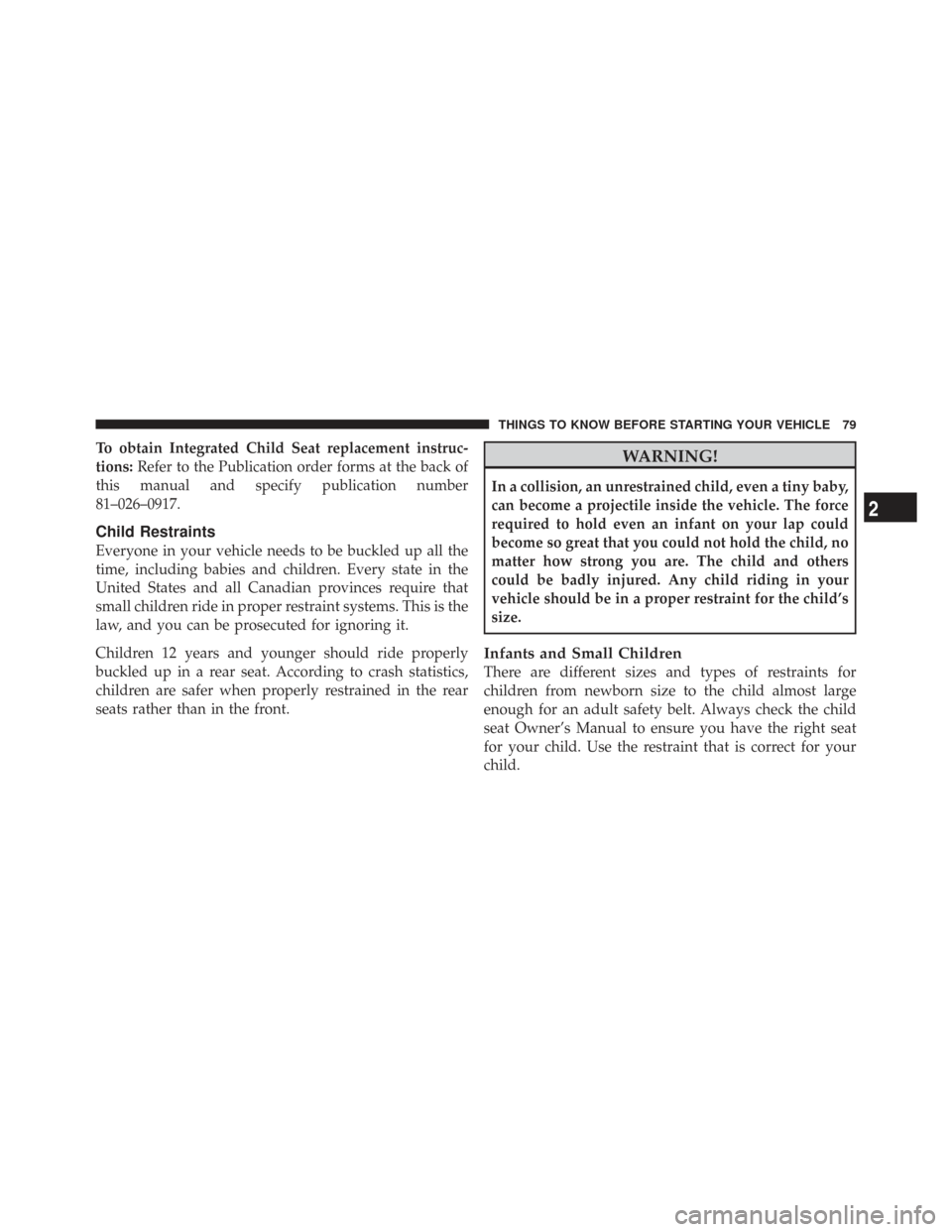
To obtain Integrated Child Seat replacement instruc-
tions:Refer to the Publication order forms at the back of
this manual and specify publication number
81–026–0917.
Child Restraints
Everyone in your vehicle needs to be buckled up all the
time, including babies and children. Every state in the
United States and all Canadian provinces require that
small children ride in proper restraint systems. This is the
law, and you can be prosecuted for ignoring it.
Children 12 years and younger should ride properly
buckled up in a rear seat. According to crash statistics,
children are safer when properly restrained in the rear
seats rather than in the front.
WARNING!
In a collision, an unrestrained child, even a tiny baby,
can become a projectile inside the vehicle. The force
required to hold even an infant on your lap could
become so great that you could not hold the child, no
matter how strong you are. The child and others
could be badly injured. Any child riding in your
vehicle should be in a proper restraint for the child’s
size.
Infants and Small Children
There are different sizes and types of restraints for
children from newborn size to the child almost large
enough for an adult safety belt. Always check the child
seat Owner’s Manual to ensure you have the right seat
for your child. Use the restraint that is correct for your
child.
2
THINGS TO KNOW BEFORE STARTING YOUR VEHICLE 79
Page 82 of 543
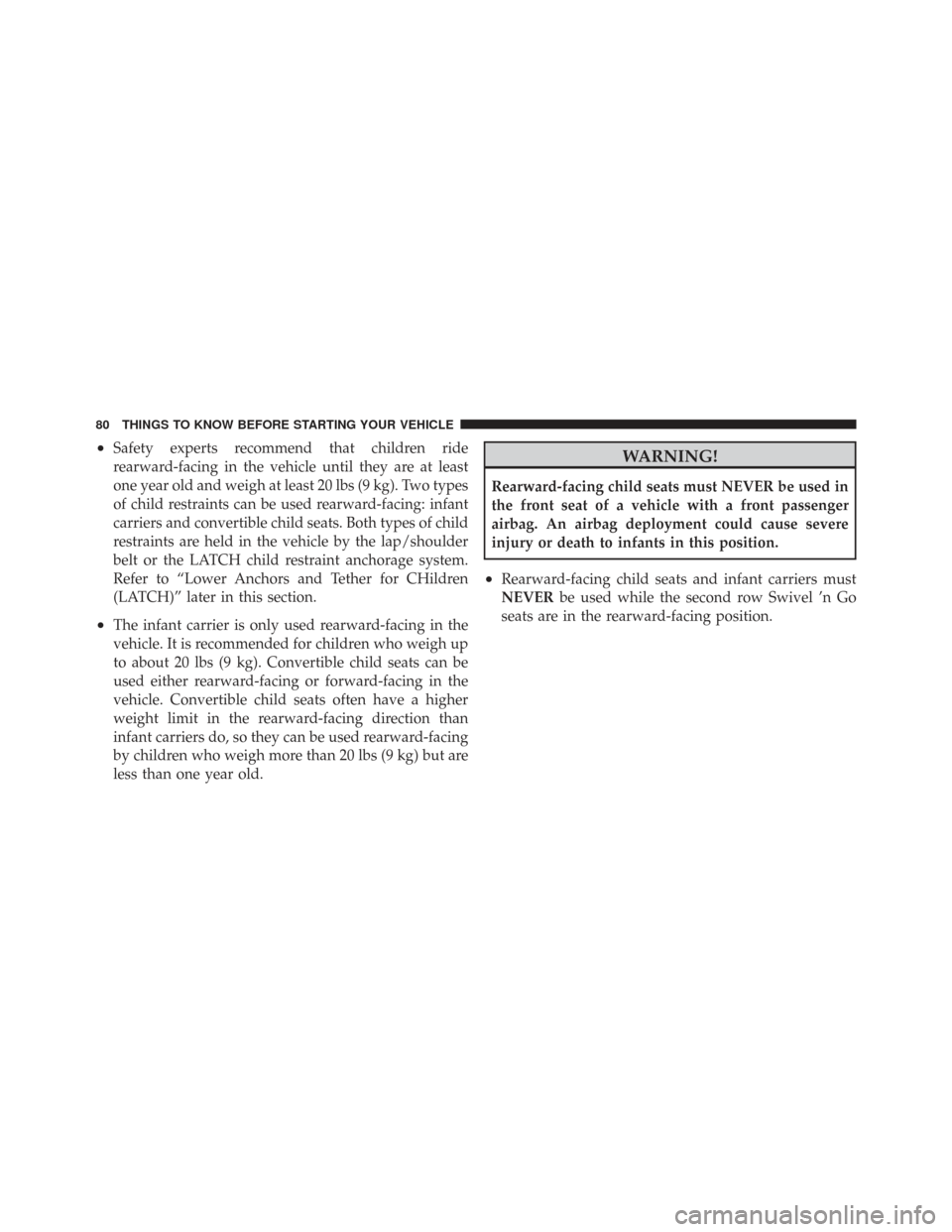
•Safety experts recommend that children ride
rearward-facing in the vehicle until they are at least
one year old and weigh at least 20 lbs (9 kg). Two types
of child restraints can be used rearward-facing: infant
carriers and convertible child seats. Both types of child
restraints are held in the vehicle by the lap/shoulder
belt or the LATCH child restraint anchorage system.
Refer to “Lower Anchors and Tether for CHildren
(LATCH)” later in this section.
•The infant carrier is only used rearward-facing in the
vehicle. It is recommended for children who weigh up
to about 20 lbs (9 kg). Convertible child seats can be
used either rearward-facing or forward-facing in the
vehicle. Convertible child seats often have a higher
weight limit in the rearward-facing direction than
infant carriers do, so they can be used rearward-facing
by children who weigh more than 20 lbs (9 kg) but are
less than one year old.
WARNING!
Rearward-facing child seats must NEVER be used in
the front seat of a vehicle with a front passenger
airbag. An airbag deployment could cause severe
injury or death to infants in this position.
•Rearward-facing child seats and infant carriers must
NEVERbe used while the second row Swivel ’n Go
seats are in the rearward-facing position.
80 THINGS TO KNOW BEFORE STARTING YOUR VEHICLE
Page 83 of 543
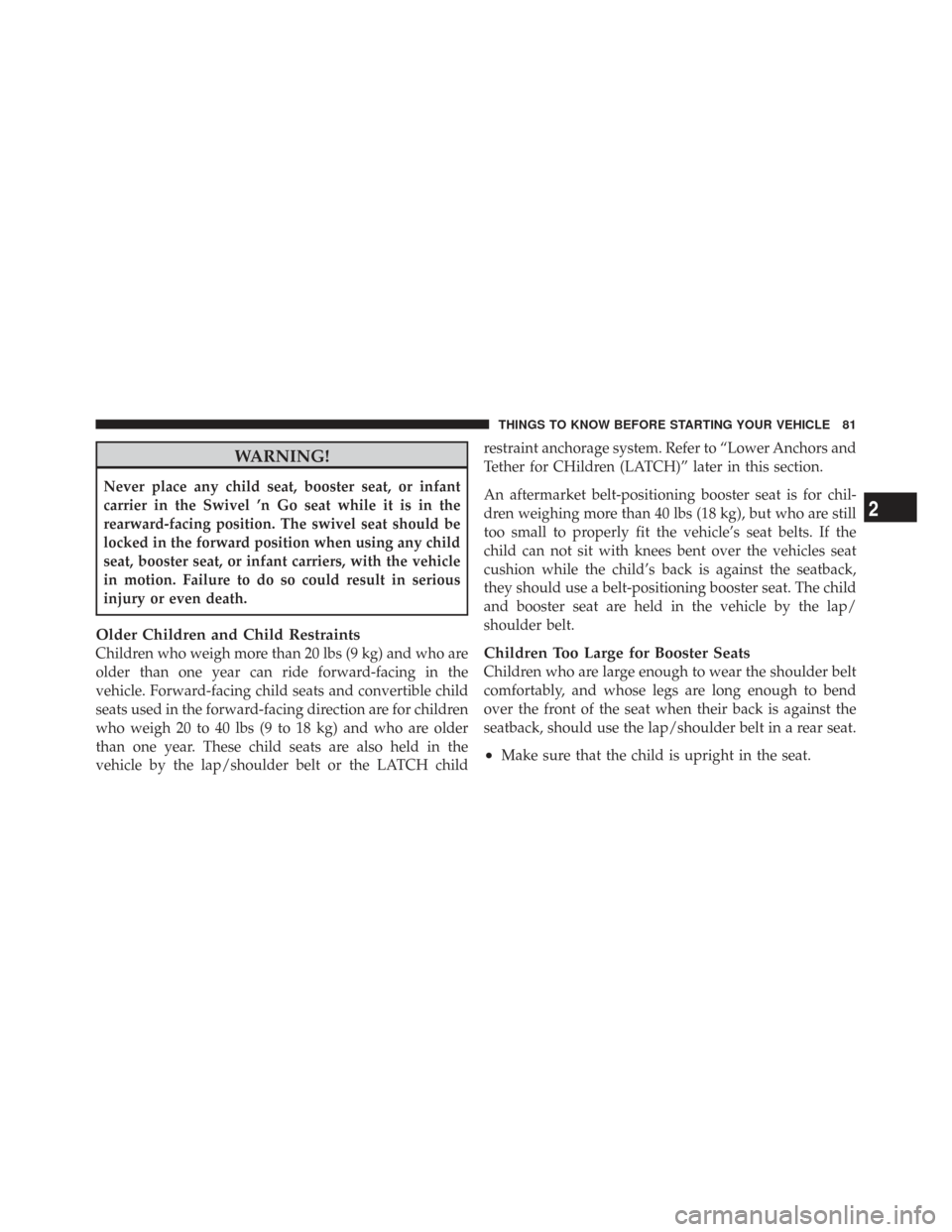
WARNING!
Never place any child seat, booster seat, or infant
carrier in the Swivel ’n Go seat while it is in the
rearward-facing position. The swivel seat should be
locked in the forward position when using any child
seat, booster seat, or infant carriers, with the vehicle
in motion. Failure to do so could result in serious
injury or even death.
Older Children and Child Restraints
Children who weigh more than 20 lbs (9 kg) and who are
older than one year can ride forward-facing in the
vehicle. Forward-facing child seats and convertible child
seats used in the forward-facing direction are for children
who weigh 20 to 40 lbs (9 to 18 kg) and who are older
than one year. These child seats are also held in the
vehicle by the lap/shoulder belt or the LATCH childrestraint anchorage system. Refer to “Lower Anchors and
Tether for CHildren (LATCH)” later in this section.
An aftermarket belt-positioning booster seat is for chil-
dren weighing more than 40 lbs (18 kg), but who are still
too small to properly fit the vehicle’s seat belts. If the
child can not sit with knees bent over the vehicles seat
cushion while the child’s back is against the seatback,
they should use a belt-positioning booster seat. The child
and booster seat are held in the vehicle by the lap/
shoulder belt.Children Too Large for Booster Seats
Children who are large enough to wear the shoulder belt
comfortably, and whose legs are long enough to bend
over the front of the seat when their back is against the
seatback, should use the lap/shoulder belt in a rear seat.
•Make sure that the child is upright in the seat.
2
THINGS TO KNOW BEFORE STARTING YOUR VEHICLE 81
Page 84 of 543
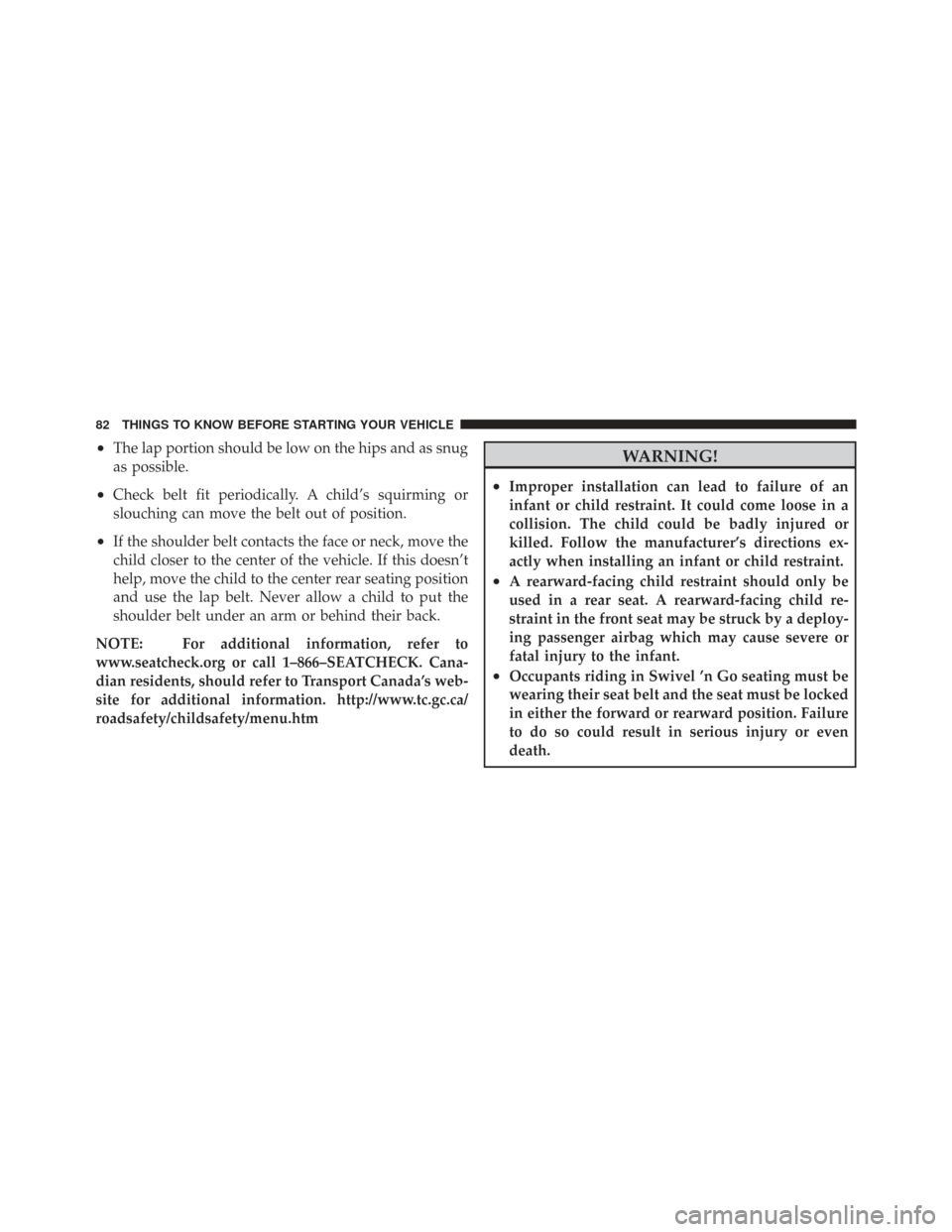
•The lap portion should be low on the hips and as snug
as possible.
•Check belt fit periodically. A child’s squirming or
slouching can move the belt out of position.
•If the shoulder belt contacts the face or neck, move the
child closer to the center of the vehicle. If this doesn’t
help, move the child to the center rear seating position
and use the lap belt. Never allow a child to put the
shoulder belt under an arm or behind their back.
NOTE: For additional information, refer to
www.seatcheck.org or call 1–866–SEATCHECK. Cana-
dian residents, should refer to Transport Canada’s web-
site for additional information. http://www.tc.gc.ca/
roadsafety/childsafety/menu.htm
WARNING!
•Improper installation can lead to failure of an
infant or child restraint. It could come loose in a
collision. The child could be badly injured or
killed. Follow the manufacturer’s directions ex-
actly when installing an infant or child restraint.
•A rearward-facing child restraint should only be
used in a rear seat. A rearward-facing child re-
straint in the front seat may be struck by a deploy-
ing passenger airbag which may cause severe or
fatal injury to the infant.
•Occupants riding in Swivel ’n Go seating must be
wearing their seat belt and the seat must be locked
in either the forward or rearward position. Failure
to do so could result in serious injury or even
death.
82 THINGS TO KNOW BEFORE STARTING YOUR VEHICLE
Page 85 of 543
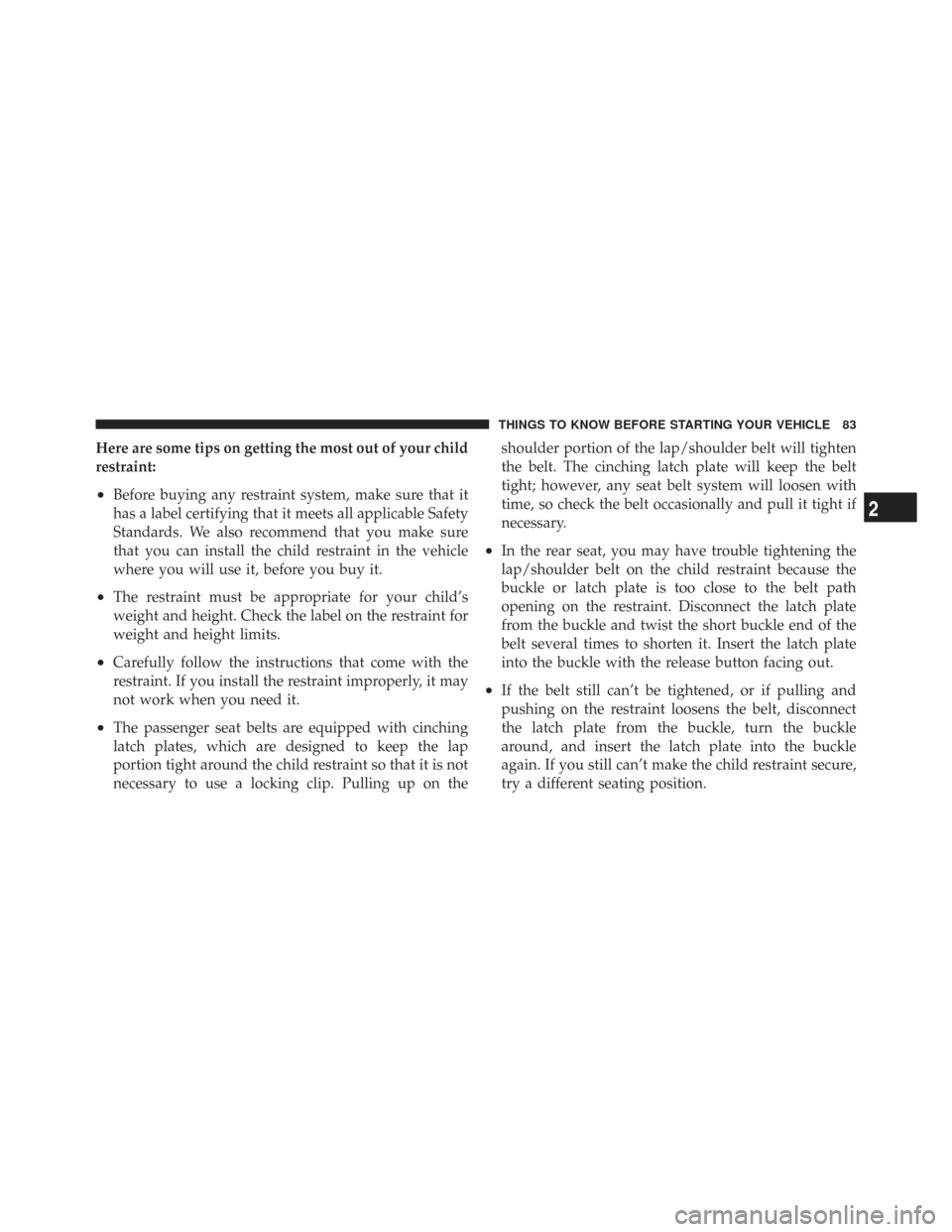
Here are some tips on getting the most out of your child
restraint:
•Before buying any restraint system, make sure that it
has a label certifying that it meets all applicable Safety
Standards. We also recommend that you make sure
that you can install the child restraint in the vehicle
where you will use it, before you buy it.
•The restraint must be appropriate for your child’s
weight and height. Check the label on the restraint for
weight and height limits.
•Carefully follow the instructions that come with the
restraint. If you install the restraint improperly, it may
not work when you need it.
•The passenger seat belts are equipped with cinching
latch plates, which are designed to keep the lap
portion tight around the child restraint so that it is not
necessary to use a locking clip. Pulling up on theshoulder portion of the lap/shoulder belt will tighten
the belt. The cinching latch plate will keep the belt
tight; however, any seat belt system will loosen with
time, so check the belt occasionally and pull it tight if
necessary.
•In the rear seat, you may have trouble tightening the
lap/shoulder belt on the child restraint because the
buckle or latch plate is too close to the belt path
opening on the restraint. Disconnect the latch plate
from the buckle and twist the short buckle end of the
belt several times to shorten it. Insert the latch plate
into the buckle with the release button facing out.
•If the belt still can’t be tightened, or if pulling and
pushing on the restraint loosens the belt, disconnect
the latch plate from the buckle, turn the buckle
around, and insert the latch plate into the buckle
again. If you still can’t make the child restraint secure,
try a different seating position.
2
THINGS TO KNOW BEFORE STARTING YOUR VEHICLE 83
Page 86 of 543
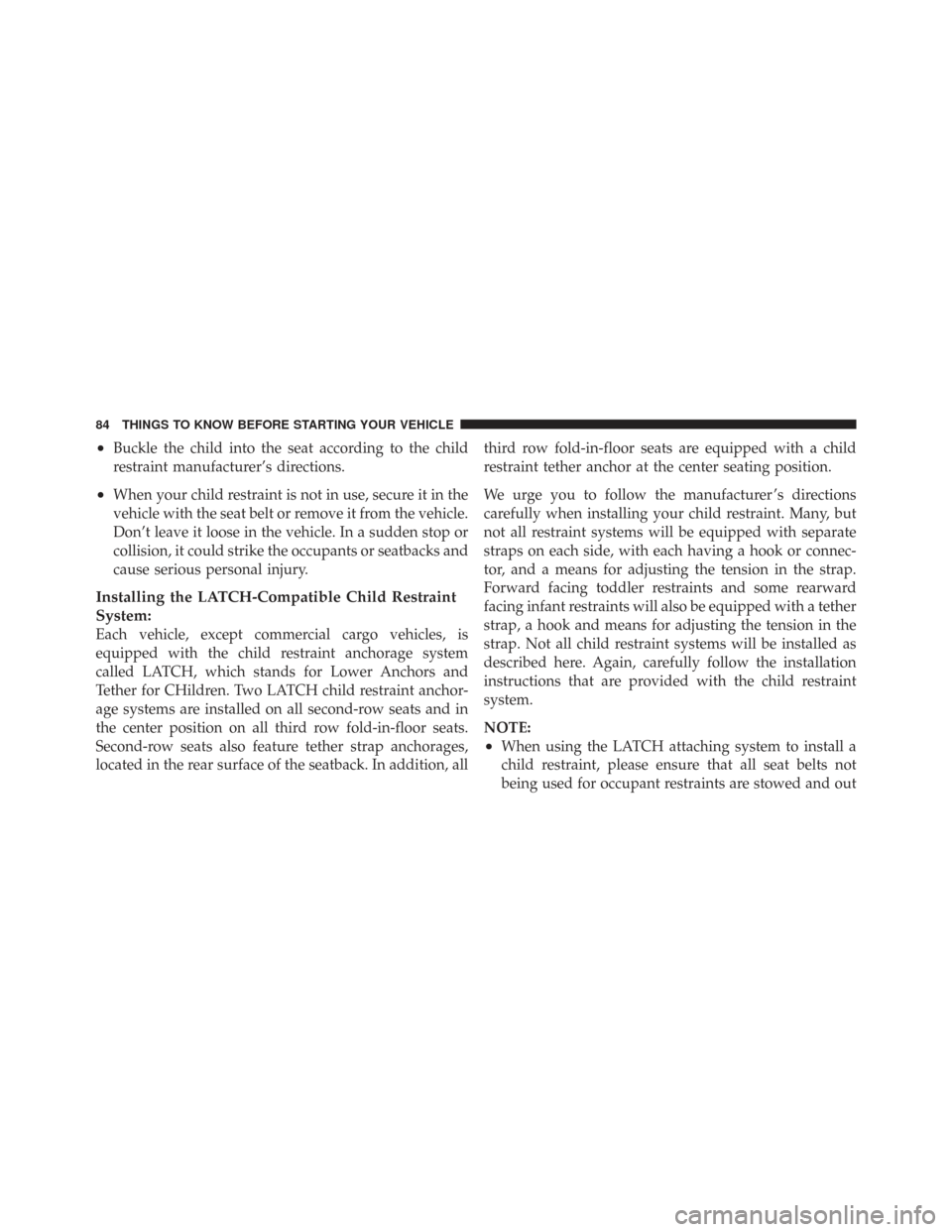
•Buckle the child into the seat according to the child
restraint manufacturer’s directions.
•When your child restraint is not in use, secure it in the
vehicle with the seat belt or remove it from the vehicle.
Don’t leave it loose in the vehicle. In a sudden stop or
collision, it could strike the occupants or seatbacks and
cause serious personal injury.
Installing the LATCH-Compatible Child Restraint
System:
Each vehicle, except commercial cargo vehicles, is
equipped with the child restraint anchorage system
called LATCH, which stands for Lower Anchors and
Tether for CHildren. Two LATCH child restraint anchor-
age systems are installed on all second-row seats and in
the center position on all third row fold-in-floor seats.
Second-row seats also feature tether strap anchorages,
located in the rear surface of the seatback. In addition, allthird row fold-in-floor seats are equipped with a child
restraint tether anchor at the center seating position.
We urge you to follow the manufacturer ’s directions
carefully when installing your child restraint. Many, but
not all restraint systems will be equipped with separate
straps on each side, with each having a hook or connec-
tor, and a means for adjusting the tension in the strap.
Forward facing toddler restraints and some rearward
facing infant restraints will also be equipped with a tether
strap, a hook and means for adjusting the tension in the
strap. Not all child restraint systems will be installed as
described here. Again, carefully follow the installation
instructions that are provided with the child restraint
system.
NOTE:
•When using the LATCH attaching system to install a
child restraint, please ensure that all seat belts not
being used for occupant restraints are stowed and out
84 THINGS TO KNOW BEFORE STARTING YOUR VEHICLE
Page 87 of 543
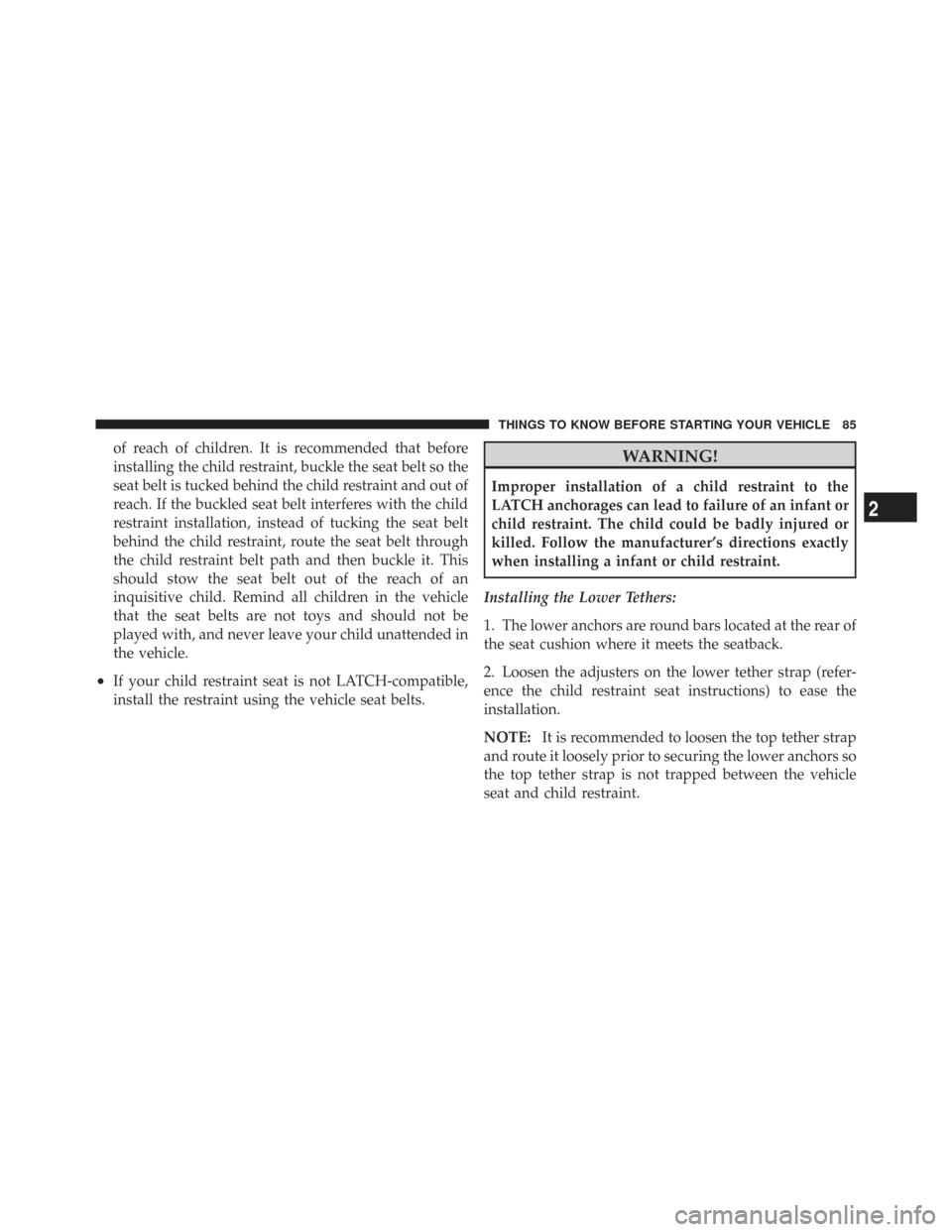
of reach of children. It is recommended that before
installing the child restraint, buckle the seat belt so the
seat belt is tucked behind the child restraint and out of
reach. If the buckled seat belt interferes with the child
restraint installation, instead of tucking the seat belt
behind the child restraint, route the seat belt through
the child restraint belt path and then buckle it. This
should stow the seat belt out of the reach of an
inquisitive child. Remind all children in the vehicle
that the seat belts are not toys and should not be
played with, and never leave your child unattended in
the vehicle.
•If your child restraint seat is not LATCH-compatible,
install the restraint using the vehicle seat belts.
WARNING!
Improper installation of a child restraint to the
LATCH anchorages can lead to failure of an infant or
child restraint. The child could be badly injured or
killed. Follow the manufacturer’s directions exactly
when installing a infant or child restraint.
Installing the Lower Tethers:
1. The lower anchors are round bars located at the rear of
the seat cushion where it meets the seatback.
2. Loosen the adjusters on the lower tether strap (refer-
ence the child restraint seat instructions) to ease the
installation.
NOTE: It is recommended to loosen the top tether strap
and route it loosely prior to securing the lower anchors so
the top tether strap is not trapped between the vehicle
seat and child restraint.
2
THINGS TO KNOW BEFORE STARTING YOUR VEHICLE 85
Page 88 of 543
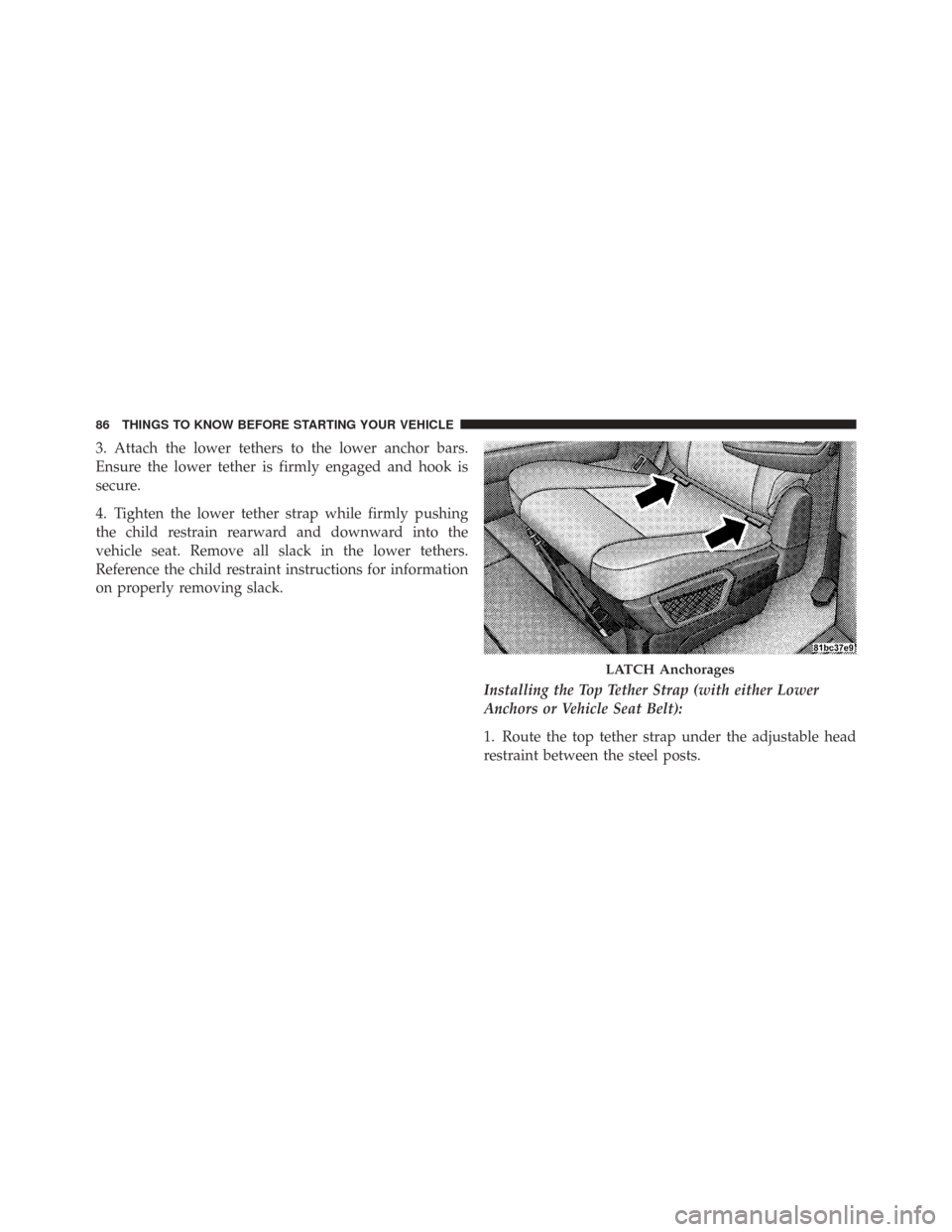
3. Attach the lower tethers to the lower anchor bars.
Ensure the lower tether is firmly engaged and hook is
secure.
4. Tighten the lower tether strap while firmly pushing
the child restrain rearward and downward into the
vehicle seat. Remove all slack in the lower tethers.
Reference the child restraint instructions for information
on properly removing slack.Installing the Top Tether Strap (with either Lower
Anchors or Vehicle Seat Belt):
1. Route the top tether strap under the adjustable head
restraint between the steel posts.
LATCH Anchorages
86 THINGS TO KNOW BEFORE STARTING YOUR VEHICLE
Page 89 of 543
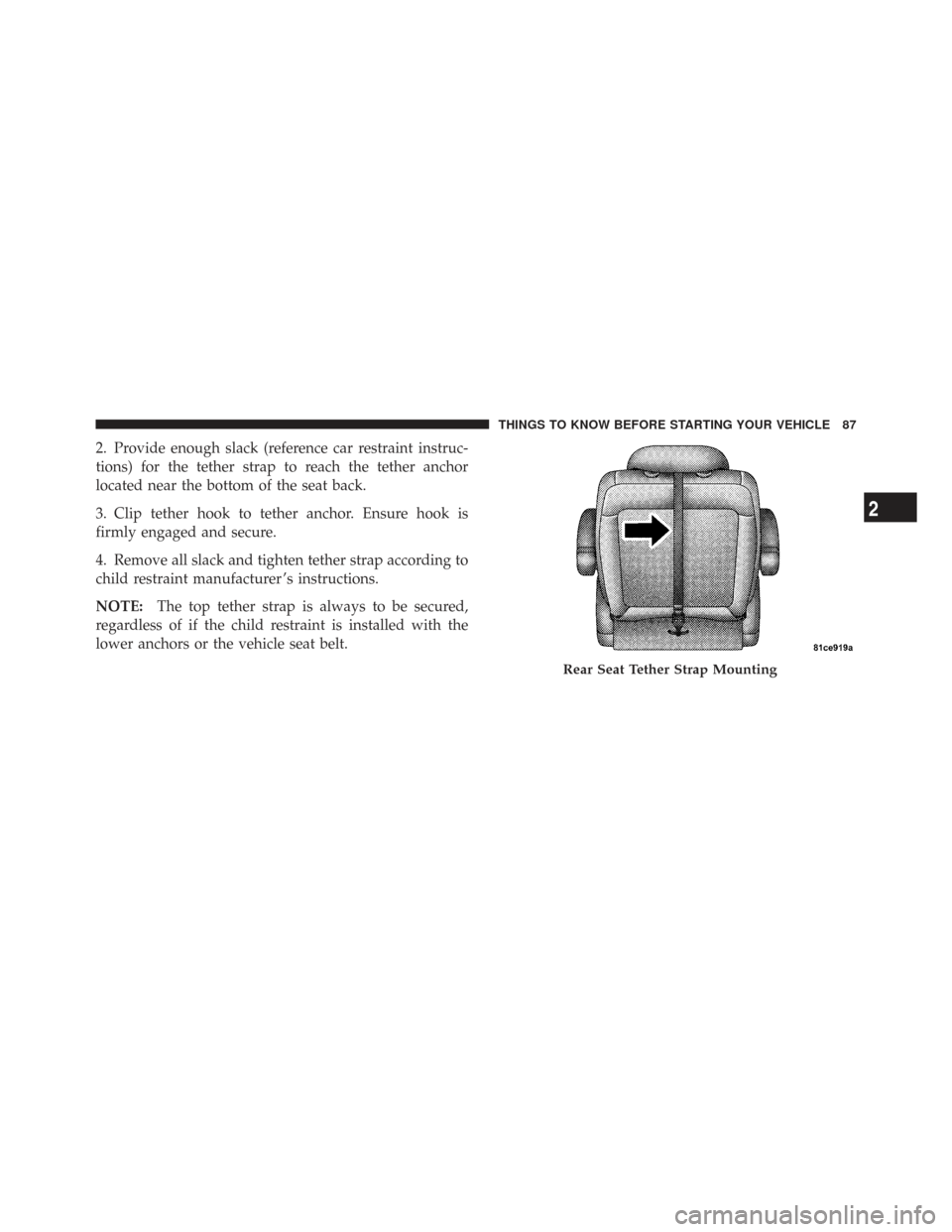
2. Provide enough slack (reference car restraint instruc-
tions) for the tether strap to reach the tether anchor
located near the bottom of the seat back.
3. Clip tether hook to tether anchor. Ensure hook is
firmly engaged and secure.
4. Remove all slack and tighten tether strap according to
child restraint manufacturer ’s instructions.
NOTE:The top tether strap is always to be secured,
regardless of if the child restraint is installed with the
lower anchors or the vehicle seat belt.
Rear Seat Tether Strap Mounting
2
THINGS TO KNOW BEFORE STARTING YOUR VEHICLE 87
Page 90 of 543
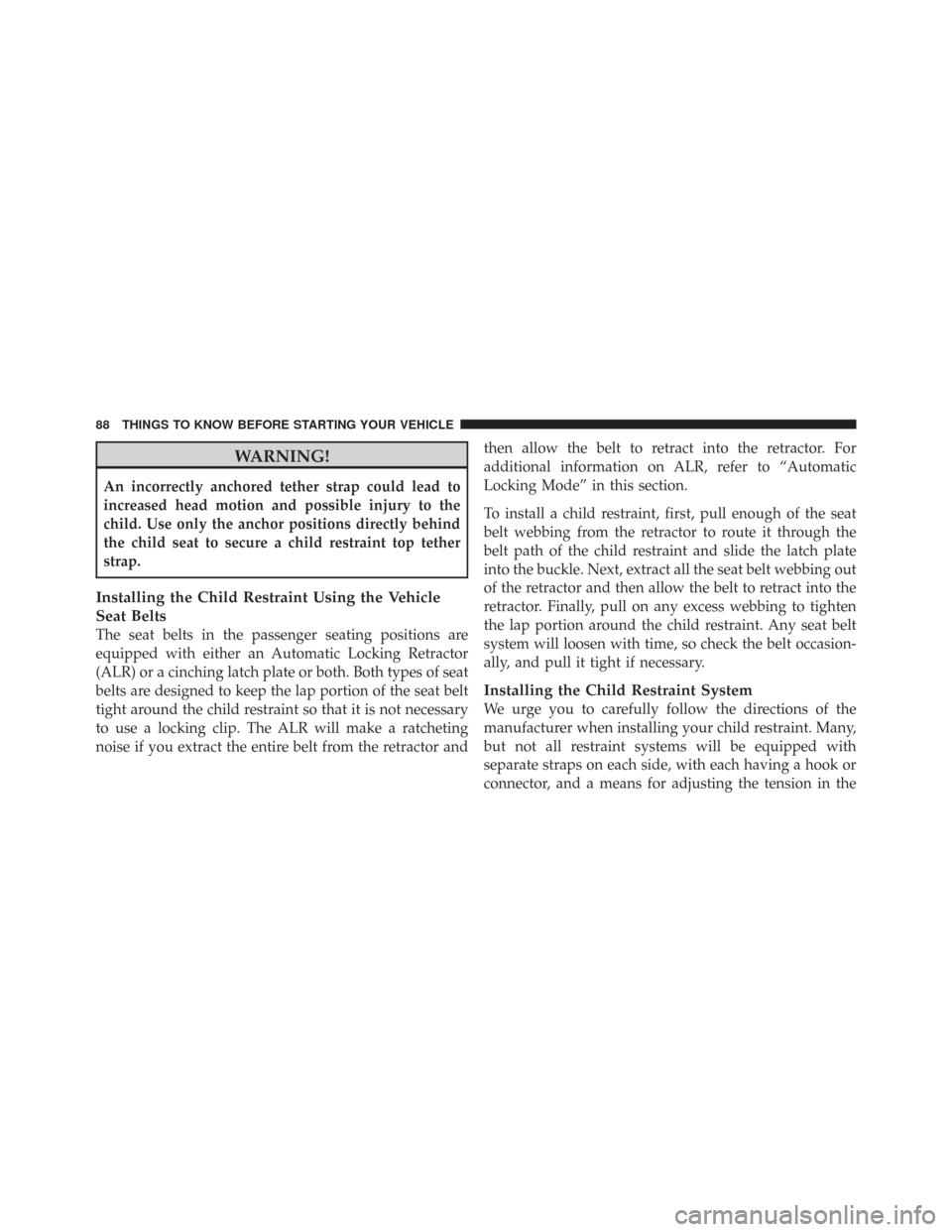
WARNING!
An incorrectly anchored tether strap could lead to
increased head motion and possible injury to the
child. Use only the anchor positions directly behind
the child seat to secure a child restraint top tether
strap.
Installing the Child Restraint Using the Vehicle
Seat Belts
The seat belts in the passenger seating positions are
equipped with either an Automatic Locking Retractor
(ALR) or a cinching latch plate or both. Both types of seat
belts are designed to keep the lap portion of the seat belt
tight around the child restraint so that it is not necessary
to use a locking clip. The ALR will make a ratcheting
noise if you extract the entire belt from the retractor andthen allow the belt to retract into the retractor. For
additional information on ALR, refer to “Automatic
Locking Mode” in this section.
To install a child restraint, first, pull enough of the seat
belt webbing from the retractor to route it through the
belt path of the child restraint and slide the latch plate
into the buckle. Next, extract all the seat belt webbing out
of the retractor and then allow the belt to retract into the
retractor. Finally, pull on any excess webbing to tighten
the lap portion around the child restraint. Any seat belt
system will loosen with time, so check the belt occasion-
ally, and pull it tight if necessary.
Installing the Child Restraint System
We urge you to carefully follow the directions of the
manufacturer when installing your child restraint. Many,
but not all restraint systems will be equipped with
separate straps on each side, with each having a hook or
connector, and a means for adjusting the tension in the
88 THINGS TO KNOW BEFORE STARTING YOUR VEHICLE